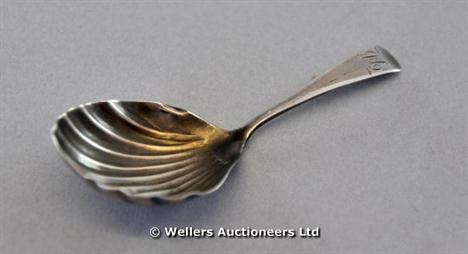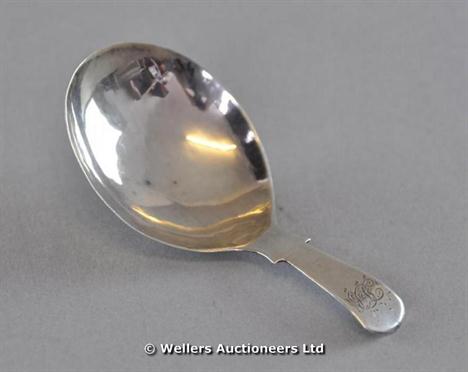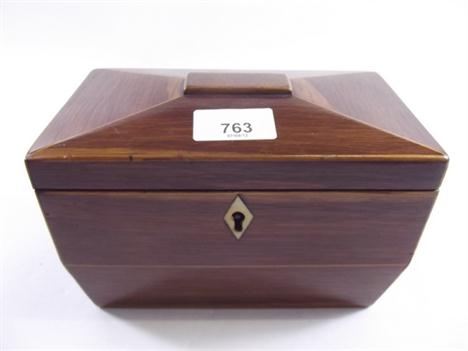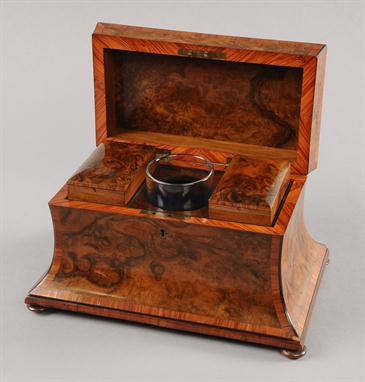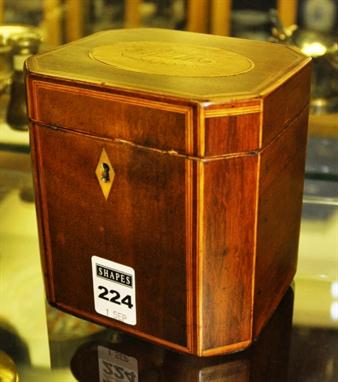We found 81449 price guide item(s) matching your search
There are 81449 lots that match your search criteria. Subscribe now to get instant access to the full price guide service.
Click here to subscribe- List
- Grid
-
81449 item(s)/page
A REGENCY SILVER CADDY SPOON, with shaped oval bowl and upright fiddle pattern handle, pin-struck and with bright cut decoration, by James Collins, Birmingham 1832, together with a silver and mother-of-pearl handled folding pocket knife, Sheffield 1912, and a 19th Century Chinese engraved mother-of-pearl rectangular lidded box, with white metal hinges and thumbpiece, 7.2cm wide (3)
A Victorian mahogany mercury stick barometer. A. Abraham, Liverpool, circa 1840. With concave-sided upstand above glazed ivory vernier scale calibrated in barometric inches and with the usual observations beneath signature A. ABRAHAM, LIVERPOOL to right hand side opposing mercury Fahrenheit and Reaumur scale thermometer to the left, the trunk with ivory vernier adjustment screw to throat and fine caddy moulded angles over circular base with domed cistern cover and level adjustment square to underside, 95cm (37.5ins) high. Abraham Abraham & Co. are recorded in Banfield, Edwin BAROMETER MAKERS AND RETAILERS 1660-1900 as working from several addresses in Liverpool 1817-75. Banfield describes them as ‘important makers’ who exhibited at the Great Exhibition at the Crystal Palace in 1851.
A George V silver mounted ivory small carriage timepiece. Unsigned, London, 1921. The French eight-day movement with platform lever escapement and numbered 1581 to backplate, the 1.25 inch circular white Roman numeral dial with blued steel spade hands set behind a convex glazed silver bezel, the case with hinged silver scroll shaped handle and circular glazed escapement aperture above caddy moulded cornice and three-quarter column uprights to corners, on conforming moulded base with bun feet, the mounts marked for Edwin Blyde & Co. Ltd., London 1921, 9cm (3.5ins) high.
A French gilt brass and lapis lazuli miniature carriage timepiece. Unsigned, circa 1900. The eight-day movement with replaced platform lever escapement and numbered 1186 to backplate, with rectangular white enamel Roman numeral dial and blued steel spade hands, the gilt brass bevel glazed case with hinged carrying handle above decorated mouldings and lapis lazuli caddy moulded corner uprights, on squab feet, 8.5cm (3.25ins) high excluding handle.
A mahogany striking dial clock. The dial signed for John Scott, London, late 18th century and later. The five pillar twin fusee bell striking movement now with anchor escapement, the 12 inch circular single sheet silvered brass Roman numeral dial signed John Scott, London to centre and with Arabic five minutes to outer track, with pierced blued steel hands and within ogee turned glazed wood bezel, the circular case probably of later date with caddy moulded edge to front, door to left hand side and with pendulum adjustment flap to base, 38cm (15ins) diameter.
A Victorian mahogany domestic wall regulator. Unsigned, late 19th century. The four pillar movement with deadbeat escapement, Harrison’s maintaining power and invar rod pendulum with cylindrical tall alloy bob incorporating brass compensation tube, the 14 inch circular cream painted Roman numeral dial with subsidiary seconds dial and bearing inscription QUEENS COLLEGE, CAMBRIDGE to centre, with steel spade hands and cast brass bevel-glazed bezel with canted inner edge, the case with circular moulded dial surround to hood above concave moulding with plain frieze to throat and bevel-glazed rectangular caddy moulded door flanked by canted angles to trunk, the chisel-shaped foot with applied rectangular panel decoration, 173cm (68ins) high.
A Scottish Regency mahogany eight-day longcase clock. G. Lumsden, Edinburgh, circa 1825. The four pillar rack and bell striking movement with 13 inch circular white painted Roman numeral dial with subsidiary seconds and calendar dials and signed G. LUMSDEN, EDINBURGH to centre, the drum-head case with giltwood canted fillet to the glazed hinged dial surround above waisted section and raised throat mouldings, the trunk with shallow-arch top caddy moulded door flanked by canted angles, on shaped panel outline fronted plinth base with moulded skirt, 201cm (79ins) high. A George Lumsden is recorded in Baillie, G.H. Watchmakers & Clockmakers of the World as working in Pittenweem, 1818-49.
A rare George I oak eight-day musical longcase clock. Benjamin Rodgers, Chesterfield, circa 1730. The substantial five-pillar triple train inside countwheel bell striking movement playing a choice of two tunes via eight bells with fifteen hammers every four hours, with original anchor escapement and outside fly with adjustable vanes for the music train, the 12 inch square brass dial with subsidiary second dial and foliate engraved calendar aperture to the matted centre within applied silvered Roman numeral chapter ring with foliate half hour markers, Arabic five minutes to outer track and signed Benjamin Rodgers to lower edge, the angles with applied female mask and scroll spandrels, with tune selection lever at 9 o’clock and pierced steel hands, the case with elaborate stepped and moulded caddy surmount above ogee cornice, plain frieze and three quarter columns to the glazed hood door, the trunk with complex mouldings to throat above rectangular door with canted upper angles, decorative brass hinges and centred with a gilt lenticle, on plain plinth base with moulded skirt, 242cm (95.5ins) high. Benjamin Rodgers is recorded in Hughes, Roy G. and Craven, Maxwell Clockmakers & Watchmakers of DERBYSHIRE as working in Chesterfield circa 1729-40. The current lot formerly belonged to the collection of the late John Hooper and was purchased by the current owner in these rooms from the sale of the Library & Workshop of John Hooper 10th February 2009 lot 99 for £3,800 hammer.
A George III brass mounted ebonised table clock. John Ellicott, London, mid 18th century and later. The twin chain fusee movement with five substantial disc-knopped pillars and thick plates, now with deadbeat escapement, chiming the quarters on the original nest of six graduated bells and with passing strike on a single larger bell, the backplate retaining original backcock apron and engraved with symmetrical foliate scrolls around a central cartouche signed John Ellicott, London, the 7 inch brass break arch dial with calendar aperture to the matted centre within applied silvered Roman numeral chapter ring with Arabic five minutes to outer track and repeat signature to lower edge, with fine pierced blued steel hands and rococo scroll cast spandrels to angles, the arch with subsidiary Strike/Silent selection dial flanked by conforming mounts, the inverted bell-top case with recessed brass fillet inserts to the front door aperture and upper quadrant sound frets flanked by caddy moulded angles, the sides with conforming circular over concave topped rectangular windows, on shallow cavetto moulded skirt base with cast brass squab feet (movement with alterations), 47cm (18.5cm) high excluding handle. John Ellicott F.R.S. is recorded in Baillie, G.H. Watchmakers & Clockmakers of the World as born 1706 to John Ellicott senior, a Cornish clockmaker who had gained his Freedom of the Clockmakers’ Company in 1696 and died 1733. John junior worked from Swithin’s Alley, Royal Exchange, London and was elected member of the Royal Society in 1738. He published works on horology in 1739 and 1753 and is particularly noted for the development of the cylinder escapement and a form of compensated pendulum; he also maintained a private observatory at his home in Hackney. John Ellicott was later appointed as Clockmaker to George III, and took his son, Edward into partnership in 1760 which lasted until his death in 1772. The current lot was originally made as an hour-striking clock with verge escapement and pull quarter repeat on six bells. The movement was modified in the mid to late 19th century to chime the quarters every hour (using the bells and part of the mechanism for the original pull-quarter repeat facility) and to strike a single blow on the larger bell every hour. At this time the escapement was also converted from verge to deadbeat. These modifications were very well executed hence the clock presents as a good decorative example. Conversely the movement perhaps has the potential to be converted back to original specification as much of the original mechanism remains.
A George III ebonised table clock. Dowson and Peene, London, circa 1760. The five pillar twin fusee bell striking movement with verge escapement and symmetrical foliate scroll engraved backplate, the 7 inch brass break-arch dial with calendar and false bob apertures and silvered arched nameplate Dowson & Peene, LONDON to the matted centre within applied silvered Roman numeral chapter ring with Arabic five minutes to outer track, the angles with rococo scroll cast spandrels beneath arch with subsidiary Strike/Silent selection dial flanked by conforming mounts, the inverted bell top case with brass carrying handle above cast brass upper quadrant frets and raised mouldings flanked by caddy moulded angles to the front door, the sides with circular over concave-topped rectangular brass fishscale sound frets, on shallow cavetto moulded skirt base with squab feet, 47cm (18.5ins) high excluding handle. The partnership Dowson and Peene is recorded in Baillie, G.H. Old Clocks and Watches and their Makers as working from Gray’s Inn circa 1800, however as the current lot can be stylistically dated to around 1760 the partnership must have been working earlier than the record suggests.
A walnut and floral marquetry eight-day longcase clock. The dial bearing signature for David Lestourgeon, London, early 18th century and later. The later century four pillar rack and bell striking movement fitted to the original 12 inch square brass dial with ringed winding holes, subsidiary seconds dial and herringbone border engraved calendar aperture to the matted centre within applied silvered Roman numeral chapter ring with cruciform half hour markers Arabic five minutes to outer track and bearing signature D. Lestourgeon, London to lower edge, the angles applied with twin cherub and crown cast spandrels, in a case with later inlaid ogee shaped caddy upstand above moulded cornice with plain frieze and three-quarter columns applied to the foliate trail decorated hood door, the trunk with conforming concave throat above elaborate brass lenticle centred door decorated with intense bird inhabited foliage on an ebonised ground and with decorative repeating border to surround, the sides with twin triple-line bordered crossbanded panels, on later line panel inlaid plinth base with moulded skirt (with alterations), 250cm (98.5ins) high.
A fine Charles II ebony table clock. John Knibb, Oxford, of ‘phase III’ design circa 1685-90. The fully latched twin fusee movement with typical Knibb pattern baluster turned pillars, verge escapement and striking the hours on a bell via a crossed-out numbered countwheel mounted to the rear of the movement, the backplate engraved with tulips and symmetrical scrolling foliage incorporating signature John Knibb, Oxon Fecit in a downward curve toward the lower margin, the 7 inch square gilt brass dial with calendar aperture to the finely matted centre within applied silvered Roman numeral chapter ring with trident half hour markers and Arabic five minutes within the narrow outer track, with fine sculpted blued steel hands and angles applied with gilt winged cherub head spandrels with engraved repeat signature to lower margin, the ebony veneered case with typical Knibb pattern foliate-bud tied hinged gilt brass carrying handle to the domed caddy surmount above moulded cornice and foliate scroll pierced lozenge sound fret to the upper rail of the front door, the uprights with cherub head and scroll cast gilt mounts (the left hand pivoted to reveal keyhole), the sides with rectangular side windows, on moulded shallow skirt base, 33cm (15ins) high excluding handle; with a foliate engraved and pierced brass winding key. John Knibb was born in 1650 and was apprenticed to his older brother, Joseph, in around 1664. When Joseph moved to London in 1670 to set up business (presumably in the workshop inherited from his uncle, Samuel) John, his younger brother, took on the Oxford workshop gaining the Freedom of the city on payment of a fine in 1673. Joseph Knibb retired in 1697 selling up most of his workshop before moving to Hanslop, Buckinghamshire where he made a few clocks prior to his death in 1711. John Knibb became a high profile figure within the City of Oxford twice becoming Mayor, he continued in business until his death in 1722. Due to the comparative rarity of clocks signed by John Knibb it has been suggested that his workshop may have generally served to supply Joseph’s larger concern in London. The strong similarities between John’s best work and those signed by Joseph would certainly support this view. However it is also clear that John was a high profile tradesman in the City of Oxford who trained no less than ten apprentices, therefore it is perhaps more likely that, although the two workshops were closely connected, they generally worked separately to supply clocks to differing groups of clients. The current lot is an quintessential example of a Knibb ‘phase III’ table clock with the movement possessing many typical features including distinctive baluster-turned movement pillars, crossed-out countwheel, signature in a downward curve to the foliate engraved backplate and finely sculpted blued steel hands. The case with its shouldered tied foliate-bud gilt brass handle, cornice with mouldings to underside only and winged cherub head mounts to the front door is also unmistakably Knibb in its design and detailing. All these details can be directly compared with an example by John Knibb of Oxford which sold at Christie’s King Street Magnificent Clocks 15th September 2004, Lot 38 for £44,212
A fine and rare small William III ebony table timepiece with silent pull quarter repeat. Samuel Watson, London, circa 1695. The five finned pillar single fusee movement with verge escapement and silent pull quarter repeat on two bells, the symmetrical foliate scroll engraved backplate signed Samuel Watson, LONDON to a central shaped cartouche beneath elaborate pierced backcock apron, the 5.25 inch square brass dial with single winding hole and curved false bob aperture backed with scroll engraved infill to the matted centre within applied silvered Roman numeral chapter ring with stylised sword hilt half hour markers and outer track divided to thirty second intervals and unusually numbered 0 to 60 twice, the lower edge with repeat signature, the angles applied with small winged cherub head spandrels within fine foliate scroll engraved border, the case with hinged cast gilt brass ‘Quare’ pattern double scroll carrying handle and vase centred foliate decorated repousse mount to the caddy surmount above moulded cornice and foliate scroll pierced lozenge sound fret to the upper rail of the front door the uprights with scroll decorated gilt repousse escutcheon mounts, the sides with short over long rectangular sound frets, on moulded shallow skirt base with block feet, (movement and case with old repair and restoration), 28cm (11ins) high excluding handle. Samuel Watson was an important clockmaker and mathematician who is recorded in Loomes, Brian The Early CLOCKMAKERS of Great Britain as initially working in Coventry from around 1680 where he was Sheriff in 1686 before moving to London in around 1691; he was admitted to the Clockmakers’ Company as a free Brother in 1692. He was supposedly ‘Mathematician ordinary’ to Charles II for whom he made an astronomical clock in 1682 followed by another clock which he did not finish until after the King’s death. This clock was eventually sold to Queen Mary on its completion in 1690 and is preserved at Windsor Castle albeit in a later case. He also made two further complex astronomical clocks for Isaac Newton and invented five minute repeating for watches. In November 1712 Samuel Watson approached the Clockmakers’ Company with an instrument to ‘discover the houre of the day at sea and several other useful mathematical matters’ but to no avail. The current lot is designed to sound the hours and quarters on two bells only on demand. This form of quarter repeat mechanism is thought to have been devised for timepieces destined for night-time use in the bedroom; whilst striking clocks with quarter repeat facility were generally intended to be utilised downstairs during the day and upstairs at night. As a consequence silent-pull quarter repeating timepieces are rarer as the original owner would have to be very wealthy indeed to afford a timepiece reserved exclusively for use in the bed chamber. The design of the repeat mechanism used in the current lot is very closely related to the system used by Joseph Knibb as described and illustrated in Allix, Charles and Harvey, Laurence HOBSON’S CHOICE pages 36-7. The reasoning behind the division of the outer track to thirty second intervals and the more confusing double 0-60 annotation is unknown, however the overall compact proportions and fine detailing such as the engraved border to the dial suggests that the current lot was supplied to a particularly discerning client from one of the best connected and enigmatic makers of the period.
A rare Queen Anne fruitwood table timepiece with silent-pull quarter repeat. Daniel Robinson, Nottingham, circa 1700. The five finned pillar single fusee movement with silent-pull quarter repeat on two bells and fine asymmetric foliate scroll engraved decoration incorporating a cornucopia to backplate, the 7 x 6.5 inch rectangular brass dial with herringbone border engraved calendar aperture and applied silvered oval name cartouche Dan Robinson, Nottingham to the matted centre within applied silvered Roman numeral chapter ring with cruciform half hour markers and Arabic five minutes to outer track, the angles applied with generous winged cherub head cast spandrels with foliate engraved detail between the upper two, the case with floral bud cast brass hinged carrying handle to the caddy upstand above foliate scroll sound fret to the upper rail of the front door and rectangular glazed side apertures, on moulded base, 36cm (14ins high) excluding handle. Although there appears to be no record of a Daniel Robinson working in Nottingham during this period there is a maker of this name recorded in Loomes, Brian The Early CLOCKMAKERS of Great Britain as born in London 1667, apprenticed to William Arthur 1681-8 but not freed. A few clocks are known to exist signed ‘Dan Robinson, London’ and it would be reasonable to suggest that this is the same maker who may have subsequently moved to Nottingham, perhaps in order to ensure he is beyond the jurisdiction of the Clockmakers’ Company. The current lot is designed to sound the hours and quarters on two bells only on demand. This form of quarter repeat mechanism is thought to have been devised for timepieces destined for night-time use in the bedroom; whilst striking clocks with quarter repeat facility were generally intended to be utilised downstairs during the day and upstairs at night. As a consequence silent-pull quarter repeating timepieces are rarer as the original owner would have to be very wealthy indeed to afford a timepiece reserved exclusively for use in the bed chamber. The basic design of the repeat mechanism used in the current lot is devised from the earliest form used by the Knibb family of clockmakers, and is very similar in layout to an example by Rooksby (probably John of York) illustrated in Allix, Charles and Harvey, Laurence HOBSON’S CHOICE page 68.
A William III ebony table clock. Nicholas Massey, London, circa 1700 and later. The five finned pillar twin fusee bell striking movement now with anchor escapement incorporating rise/fall regulation, the fine symmetrical foliate engraved backplate incorporating two female terms holding aloft a laurel wreath and supporting a drapery cartouche signed Nicholas Mafsy, London, with wheatear border and visible spring barrel set-up clicks, the 8.25 inch square brass dial with matted centre now within applied white Roman numeral chapter ring with Arabic five minutes to outer track, the lower angles with shaped enamel panels decorated with finely drawn puce rococo scrolls issuing floral sprays, the upper angles now with conforming subsidiary enamel STRIKE/SILENT and regulation rings applied to the original foliate scroll engraved infill and interrupting the wheatear decorated border, with pierced steel hands, the case with particularly fine heavy cast and chased hinged gilt handle incorporating figural putto terms, a snake and architectural elements to the domed caddy surmount above shouldered urn finials with foliate knops, moulded cornice and foliate scroll pierced lozenge sound fret to the upper rail of the front door, the sides with short over long rectangular apertures, on conforming moulded shallow skirt base with gadroon cast disc feet (movement and dial with older alterations), 40cm (15.75ins) high excluding handle. Nicholas Massey senior is recorded in Loomes Brian The Early CLOCKMAKERS of Great Britain as admitted as free Brother of the Clockmakers’ Company in 1682. He was a French Huguenot immigrant who is believed to have been the eldest son of Nicholas Massey of Blois who died before 1658. He worked at Cranborn Street with the business presumably passing to his sons (one of which was also called Nicholas) on his death in 1698. Nicholas junior, who was also admitted as a free Brother of the Clockmakers’ Company in 1693 is thought to have worked up to 1723. The current lot could have been made by either Nicholas Massey senior or his son of the same name. Detailing such as the fine engraved backplate with unusual signature within a drapery cartouche, and the exceptional mounts to the case suggest a strong French Huguenot influence and can be compared to the work of other immigrant makers such as Claude DuChesne. The enamel fittings to the dial appear to date to the third quarter of the 18th century and are very well detailed; they were probably fitted to the clock to give it a more ‘modern’ appearance at that time. The dial centre also has a matted circular plate carefully placed over the original in order to disguise the redundant calendar and false bob apertures, the presence of this plate (to hide the false bob aperture) suggests that the escapement was also converted at the time the new dial fittings were added.
A Royal Worcester "plain globular caddy and cover", date mark for 1898, floral decoration, on a peach ground, pattern number 1039, 14cms, (5½") and a Royal Worcester rose jar, date mark for 1900, with internal lid only, basket weave moulded, painted with flowers, on a peach ground, pattern number 1286, 16cms, (6¼"), (2).
A quantity of assorted domestic metalware, 18th - 20th century, including a composite set of eight Continental pewter lidded measures, comprising Double Litre, Litre, Demi Litre, Double Decilitre, Decilitre, Demi Decilitre and Double Centilitre, the largest 10 1/4in high; a Victorian brass skimmer in the George III style, by Pearson-Page, 22 1/4in long; a pewter platter, early 19th century, stamped ‘MTDH’ twice, 11 3/4in diameter; a George III brass folding hobgrate trivet, circa 1770, 5in high, 8 1/2in deep; a Liberty pewter tea caddy, early 20th century, 3 1/2in high; and a graduated pair of copper and brass mounted jardinieres, circa 1900, the larger example 7 1/2in high
A 19th century rectangular bow fronted tortoiseshell mounted tea caddy, the hinged lid enclosing twin lidded compartmentalised interior with ivory corners raised on canted base, lacking original bun feet, with silver wire inlay to corners, height 10cm, width 16cm (losses and af) (illustrated)
-
81449 item(s)/page













